“读万卷书,行万里路”是每一位深受中国学子的梦想。近年来,随着“中国热”在里贾纳地区的持续高涨,一批又一批本地学子在里贾纳大学孔子学院的组织下从加拿大来到中国学习。经过两周紧张而又充实的汉语学习之后,2018年 6月10日起 ,里贾纳大学孔子学院组织了11名本校大学生进行了为期两周的“发现中国,大美湖南”文化体验及汉语学习之旅。
游学团在北京的第一站就来到了孔子学院总部/国家汉办参加开营仪式,并到其附属的文化体验中心进行了参观和学习。总部老师为同学们悉心介绍了各种中国传统文化、艺术。老师精彩的解说引发了同学们的连连赞叹,中心里各种结合现代科技的展览方式让古老璀璨的文明焕发出新的勃勃生机。中心里陈列的京剧戏服和古代乐器更是激起了学生们极大的好奇和兴趣,纷纷上前体验、留影。之后,学生一行还分别到清华大学和中国传媒大学聆听了关于中国教育制度、中国传媒的发展等主题的讲座,并与两所学校师生就感兴趣地话题进行了深入、热烈的交流和探讨。这些讲座不仅令学生们感受到了中国高校不同的文化氛围,还进一步加深了他们对中国的语言、文化、社会、教育、以及政治体系等方面的了解。讲座结束后学生们纷纷表示原来对中国的了解是片面的、有限的,经过这些精彩的讲座,和与老师们、同学们面对面开诚布公的交流,他们对中国社会的了解更加客观、全面了。在北京期间,学生们还参观了天安门广场、故宫、长城、颐和园等著名名胜古迹,其中圆明园遗址公园和其背后的历史故事给学生们留下了最为深刻的印象。当面对着残破却依旧瑰丽的大理石柱,团员们沉默了,因为即使面对这样的断壁残垣,他们依旧能够依稀看到这座皇家园林当年的壮观气派,这本该属于全人类的瑰宝却在战争中毁于一旦,留给后人无限的遗憾。“这一座应该比故宫还要美的宫殿却被入侵者毁灭掉了”,团员Ana Lucia感叹道,“这让人觉得非常难过,就像我的祖国墨西哥的很多古迹一样,太可惜了。”


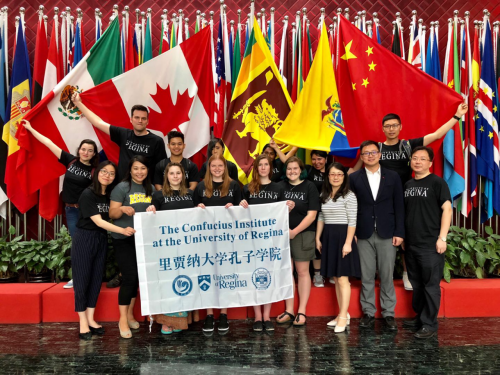
结束在北京的行程之后,游学团一行抵达了湖南,开启了另一周的中国文化体验和学习。在从北京到长沙的途中,学生们第一次乘坐了中国高铁,亲身体验它的“速度与激情”。亲民的票价,洁净的车厢,便利的设施,细致周到的乘车服务,以及沿途的秀丽风景均让同学们大开眼界。
湖南是湖湘文化体系的发源地,其多元又独特的区域文化成为了华夏文化的重要组成部分。与北京大气古朴的文化气质不同,湖南文化以其火辣热情著称。香辣的湘菜,熙熙攘攘又井井有条的街道,善良热情的湖南人民瞬间征服了团员们。在湖南省参观期间,学生们有幸参观了数座博物馆,其中包括湘绣博物馆,铜官窑遗址博物馆,以及八座国家级重点博物馆之一的湖南省博物馆,深入了解了三湘文化和湖南的历史沿革。湖南省博物馆馆藏的马王堆汉墓出土文物、商周时代青铜器物、楚文物、长沙窑瓷器、历代瓷器书画等文物将一幅幅历史长卷在团员们眼前徐徐展开,团员们无一不为湘楚文化的精妙奇绝而赞叹。特别是在拥有1200多年历史的长沙铜官窑遗址博物馆中,那一件件唐代专为出口中亚各国订制而成的瓷器让团员们切身的感受到了中华民族自古以来开放而包容的民族性和让人赞叹的创造力。此外,游学团一行还到了位于湖南永州花瑶少数民族文化村-——湖南大学定点扶贫点进行访问学习。一到寨门,热情的瑶寨人民便载歌载舞向团员们奉上自酿美酒,以最高礼仪“拦门酒”欢迎这些远道而来的客人们。仪式结束后,湖南大学艺术设计学院师生向团员们讲述了他们如何将少数民族文化与现代设计相结合起来帮助贫困地区发展经济的过程,游学团的同学们也借此机会向设计学院的师生们分享了加拿大原住民社区的此类经验。
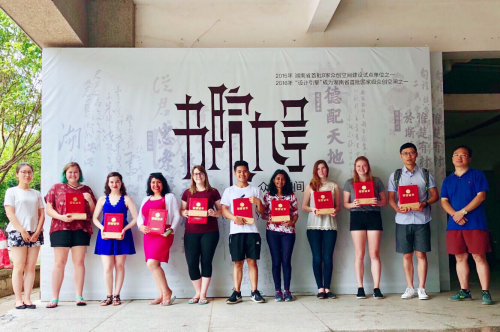
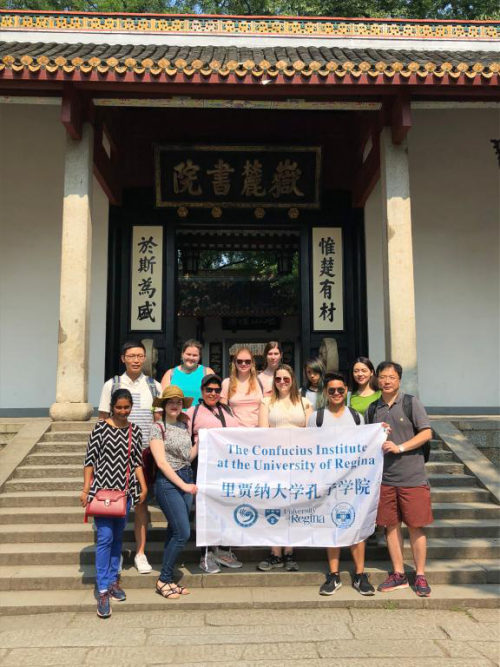
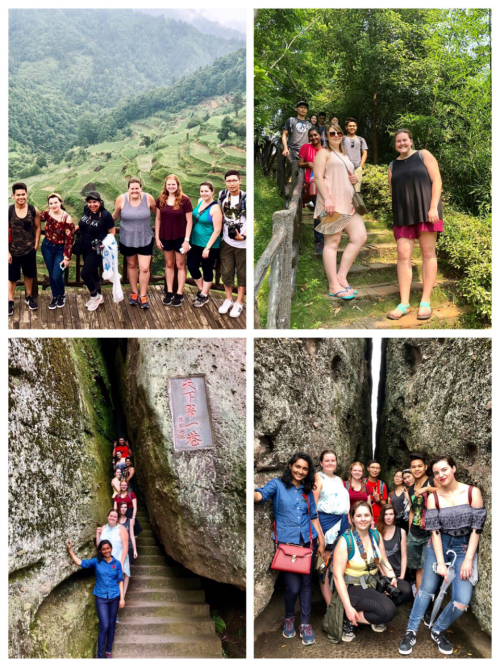
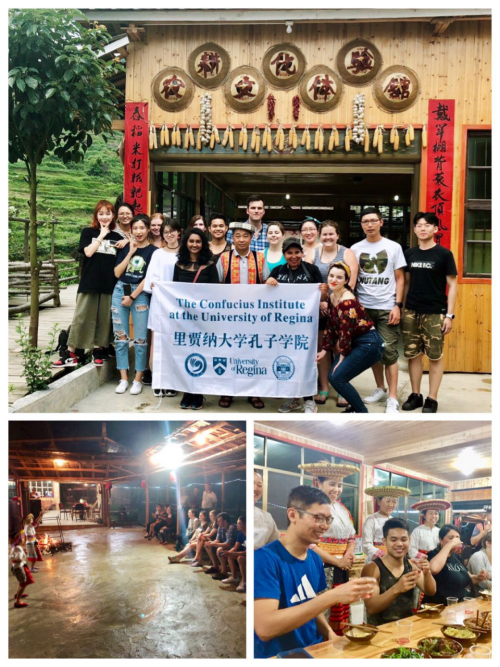
此次在中国的游学体验让不仅让学生们体验和感受了中国特色的历史和文化,真正认识当代中国,还打开了他们的视野,激发了其学习中国语言和文化的兴趣及热情。团员Wilbur已经注册了秋季学期的中文课程,他告诉带队老师:“要是明年还有机会,我希望再来中国,但不是两周,我想在这里学习,生活”。
The Chinese people always believe in “one should read as many books as they can and travel as far as they can.” In relation, there are domestic university students that took the two-week Chinese Language classes from June 10th to 23rd, 2018 in the height of “China Fever” in the Regina community. After which, the Confucius Institute successfully organized a study tour for eleven students to travel to China. The study tour provided an excellent opportunity for the participants to gain a deeper experience of the Chinese culture and practiced their Chinese language skills in China.
Upon the group’s arrival in Beijing, the capital city of China, they attended an opening ceremony at the Confucius Institute Headquarters (HanBan). At the Chinese Cultural Experience Center, they expressed a great admiration of the colourful introduction and modern display of the diverse Chinese traditional culture and arts. The students took lots of photos with great interest in the Peking Opera costumes and the ancient musical instruments.
After that, the participants attended a series of lectures at the Tsinghua University and the Communication University of China on the Chinese Educational System and the development of media in China. Through these lectures, the students learned the different cultural atmosphere in Chinese universities and gained a better understanding of the Chinese language, culture, society, education, political system, and more. The participants also had a friendly dialogue with the local students and teachers that gave a more objective and comprehensive perception of the Chinese society.
While still in Beijing, the participants visited several famous tourist attractions and historical, scenic sites that include the Tiananmen Square, the Forbidden City, the Great Wall and the Summer Palace. The group also visited the Yuanmingyuan Park wherein facing this magnificent, gorgeous royal garden was a placed that was unfortunately damaged during the war. The students were struck and silent upon learning of the incident. Ana Lucia, a student, sighed as she remarked: “It is so sad that this fabulous treasure of mankind was destroyed in the war, just like those in Mexico.”
After the trip to Beijing, the group went to Changsha City, the center for culture, education and economy of Hunan province by the high-speed train. It was the first time for most of the participants to take a high-speed train that they likened their experience with the Fast and Furious movie. More so, the students were impressed by the excellent service together with the comfortable atmosphere in the train at an affordable price.
Hu-Xiang culture originated from Hunan is characterized by its uniquely diverse regional elements and is an integral part that constitutes the Chinese culture. Hu-Xiang culture differs from Beijing with its long and remarkable history and is described as being energetic and enthusiastic. The bustling and well-arranged streets, hot and spicy Xiang cuisine and hospitable residents warmly welcomed the participants as soon as they reach Changsha City.
During the whole trip in Hunan, students visited many local museums, including the Xiang Embroidery Museum, Tongguanyao Museum, and Hunan Provincial Museum as well. These museums displayed the splendid history, folk customs, craftsmanship and natural resources of the Hunan Province, which helped the students to have a profound understanding of the regional culture. In the Hunan Provincial Museum, one of the top eight national museums in China, the participants were amazed by various ancient cultural relics, such as the unearthed relic collections of Han dynasty, bronze wares of Shang dynasty, cultural relics of Chu state, and many other precious painting and calligraphy art works of different dynasties. Meanwhile, Tongguanyao Museum features the kiln with 1,200 years history, it showcase the glamorous porcelains customized for export to central Asia in Tang dynasty that demonstrated China has been an open, inclusive, and creative nation.
Meanwhile, the group visited the Huayao Ethnic Village in Yongzhou, Hunan province that is the site of poverty alleviation supported by Hunan University to facilitate their economic development. The enthusiastic host of the Yao ethnic group held a welcoming ceremony for the participants with their homemade wine and traditional singing and dancing. Likewise, the students and teachers from the Faculty of Arts of Hunan University introduced how they have had combined modern design ideas with the ethnic group’s cultural elements in their work. The participants also shared to their local counterparts about their experience with Canadian aboriginal communities.
The participants indeed spent a wonderful time during the whole tour in China. The experience of travelling not only help them learn the Chinese history and culture but also explore the modern China that opened their mind and incited their interest to learn more about the country. “I would like to go to China again if there is an opportunity next year, and plan to study and live for a long time not only just for two weeks.” said Wilbur, who already registered for the Chinese course in this fall semester.